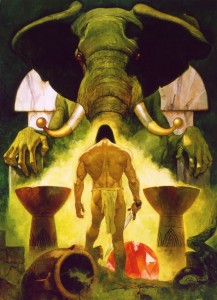Friday, July 10, 2009
posted by Steve Trout

M. John Harrison’s The Pastel City has long been one of my favorite books. Recently I read it again for the third or fourth time. It is set in a desolate future Earth, where large tracks of land are given over to polluted wastes and deserts of rust. There are ruined cities and ruined machines left over from the civilizations of the past, the Afternoon Cultures.
Across this backdrop strides tegeus-Cromis, a black-clad swordsman supreme, something of a somber Solomon Kane figure, though he is a poet rather than a Puritan. He and his fellow Methven, a knightly order that served the old king, are caught up in a new war involving the new queen, Northmen, and deadly brain-harvesting machines dug up from the past. The plot is fairly slight, and has a deus ex machine taint to the conclusion, but what stands out is the Future Gothic moodiness, the characters, and some great dialog.
Tomb the Dwarf, who is good with his hands, finds an immense exoskeleton and repairs it — strapped into it, he hoists his energy-bladed axe and shouts “I’ll shorten them!”
Tegues-Cromis, in despair, facing enemies who outnumber him vastly, pleas “Come and kill me. Just come and try.”
If you’re not familiar with this book, you should try it out. Be aware the sequels are disappointing.
Wednesday, July 8, 2009
posted by Deuce Richardson
“Bullfighting is indeed a reversion to Roman amphitheater days. I have an idea that the Mediterranean peoples have practiced it in some form or other every since the days of Crete, where it flourished, according to vases and the like.”
Robert E. Howard to HP Lovecraft, ca. January 1931

The bulls are running again in Pamplona, once the heart of medieval Vasconia, and what is now known as the Basque Country. The Feast of St. Fermin is an ancient one, with records attesting the encierro going back at least eight centuries. There are some indications that its roots extend much further. (Continue reading this post)
Sunday, July 5, 2009
posted by Leo Grin

In all the hoopla surrounding the more famous celebrity deaths of late, the death of Harve Presnell at 75 has gone largely unnoticed. Among many other performances during a long career, he ably played Dr. Howard in the biographical REH film The Whole Wide World, which also starring Rene Zellweger and Vincent D’Onofrio.
Presnell’s obit is here.

Friday, July 3, 2009
posted by Steve Trout

I’ve never been much of a Clive Barker fan, so I never saw “Lord of Illusions” when it came out. It’s been playing on our cable though, so we gave it a try. Despite Leonard Maltin’s half-hearted endorsement (“Intelligent thriller [. . .] better than the usual genre fare, but it’s thinly plotted, and condescends slightly to its audience” it was entertaining enough and I never saw any condescension.
It stars “Quantum Jump”-er and “Star Trek Enterprise” captain Scott Bakula as a out-of-his league gumshoe and a very hot, young Famke Janssen (Jean Grey of “X-Men” ) as the damsel in distress. The plot, which involves cults and real magic, has several Howardian elements, which makes me wonder if Barker is a fan.
At the start, two cultists murder a mystic, and one of them has filed teeth (not that that necessarily owes anything to Howard’s “Shadows in Zamboula” — but the other one is the creepier. This is a prelude to the main plot, which involves the PI being hired to check into whatever problem is haunting an illusionist, who then apparently dies in a stage accident. He has been hired by the sultry wife/widow whom he promptly bangs. What the illusionist feared is a man who has been dead for over a decade –a man who taught him that magic was real. In a very creepy sequence with echoes of Acheron, this dead sorcerer is brought back to life by his faithful cult.
For our P.I. hero, who seems not too far removed from Howard’s River Street, handgun fire is a hearty incantation, but in the end, it is the borrowed power of a formerly subordinate mage (the illusionist, not actually dead after all, but now getting there) who tried and failed to stem the black master’s evil — as in “People of the Black Circle” — that lets our braver and more determined hero throw the sorcerer back down to hell, in a sequence that relies on flashy special effects to the detriment of good storytelling. Still and all, a very interesting film.
Wednesday, July 1, 2009
posted by Deuce Richardson

The tortured, transcosmic being that the youthful Conan encounters in “The Tower of the Elephant” seems to have a bit of an identity problem. Said entity refers to himself as “Yogah” once and as “Yag-kosha” twice. Robert E. Howard, in his role as omnipotent narrator, refers to the last exile of green Yag as “Yag-kosha, or Yogah” and as “Yag-kosha and Yogah.”
What to make of this? How should Yara’s ultra-telluric thrall be called? By what name did that pathetic entity refer to himself, in his innermost thoughts? Short of finding a lost letter relating to the matter, or the discovery of more “Hyborian Age Notes” of some sort, nothing absolutely definitive can be stated. However, I think something can definitely be speculated. (Continue reading this post)










